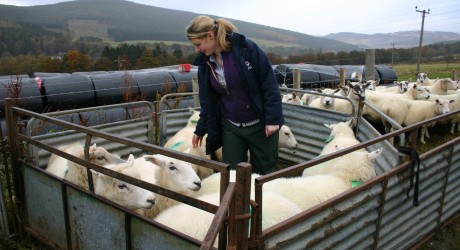TIME spent checking and preparing breeding sheep prior to turning tups in, can help boost lamb numbers and improve lamb survivability the following spring.
This was the message shared at the recent Quality Meat Scotland (QMS) Cairngorms monitor farm meeting.
The monitor farmers – George and Fiona Gordon and son Charles – farm a total of 468.23 hectares (1,157 acres), in Strathdon, based around their home farm, Lost, 45 miles west of Aberdeen.
This autumn the Gordons are putting 850 ewes and 250 gimmers to the tup.
They run a mixture of breeds and cross-breds – Scottish Blackfaces plus home-bred Mules and Lleyn crosses. Cheviot, Lleyn and Texel tups are used, with the ewe: tup ratio – 60:1.
Approximately 400 ewe lambs are retained for breeding, with the remaining lambs either finished or sold store.
The day before the meeting, the Gordons had purchased some tups which were penned alongside a selection of their ewes at the meeting, giving the community group the opportunity to assess the suitability of the tups for their duties, and the condition of the ewes pre-mating.
Kirsten Williams and Samantha Rendall, both of SAC Consulting, a division of SRUC, Scotland’s Rural College, explained some of the main pre-tupping points to bear in mind, to help ensure a productive lambing.
Tups lose 15 per cent of their body weight during the first six weeks of work, so pre-tupping they should have a condition score of 3.5 to 4.0.
Should they require feeding to achieve the required condition score, start supplementing their diet ten weeks prior to tupping, with concentrate and ad-lib roughage, taking care to avoid high levels of magnesium, which can cause stones in the urinary tract.
Recently-purchased tups, which have been fed for sale, may need gradual slimming down.
Check feet and legs are sound for tup mobility throughout the working stint.
Ensure there are no painful lesions on the brisket, which would discourage tups from mounting ewes.
Teeth should be in good order, with no abnormalities or abscesses. All vaccinations should also be up to date. Selenium is important for fertility, so if deficient dose with long-acting selenium 12 weeks prior to tupping. Vitamin A is important for sperm production.
Testicles should slide freely and have no hard lumps.Testicle size co-relates with amount of sperm produced, so circumference is important with an approximate minimum of 34 cm for a tup lamb and 36 cm for a mature tup.
While tup preparation starts approximately three months prior to tupping, Kirsten Williams and Samantha Rendall explained that ewe preparation should be a year round event.
After weaning, any ewes with problematic legs, feet, teeth or udders, should be culled.
When buying breeding females, try to buy from known, good health status flocks, otherwise vaccinate for Toxoplasmosis and Enzootic Abortion.
A minimum of eight to ten weeks prior to tupping, breeding females should be blood sampled to establish trace element (Selenium, Cobalt and Copper) levels, which contribute to fertility, foetus development, embryo survival, lamb vigour and prevention of swayback.
Action should be taken to ensure optimum trace element levels, with care taken with regard to copper when working with continental-blooded females.
A Vitamin E supplement in late pregnancy can improve lamb vigour, especially in thinner, outdoor lambing ewes.
At tupping, a female’s condition score should be between 3.0 to 3.5, with ewes flushed two to three weeks prior to tupping on either improved grazing or, if insufficient grass, with concentrate supplementation.
Body condition should be maintained during early pregnancy, and ewes stressed as little as possible as stress hinders embryo implantation which occurs between 14 to 34 days after mating.
Throughout pregnancy, to maximise embryo survival, stress should be avoided as much as possible, with minimal handling, moving or hauling of ewes. Fighting at feed troughs can also stress in-lamb ewes, as can bad weather so, where possible, pregnant ewes should be kept in well-sheltered fields.
For general information on monitor farms, plus detailed reports of meetings:www.qmscotland.co.uk/monitorfarms
Photo caption: Samatha Rendall of SAC Consulting, a Division of SRUC, Scotland’s Rural College, pictured in a pen of Lleyn cross ewes at Lost.
MEDIA RELEASE posted by QMS. You too can post media releases (aka press releases) on allmediascotland.com. For more information, email here.
Contact: Carol McLaren
Phone: 0131 472 4112
Email: cmclaren@qmscotland.co.uk
Website: http://www.qmscotland.co.uk






